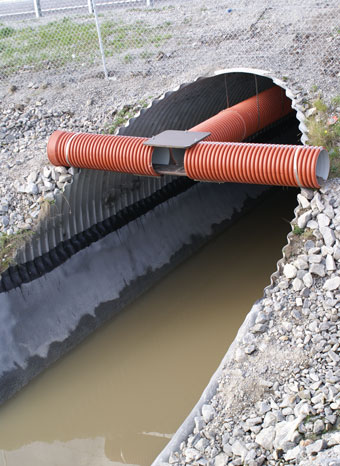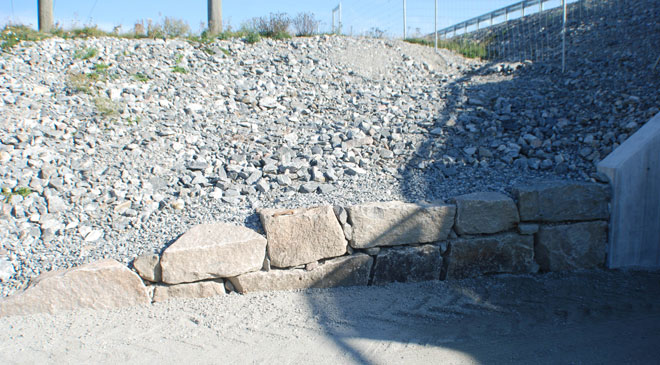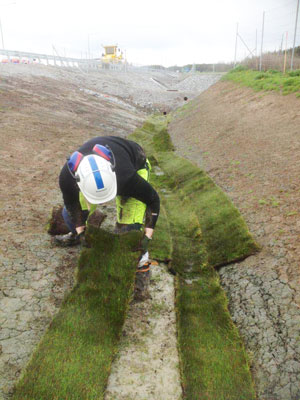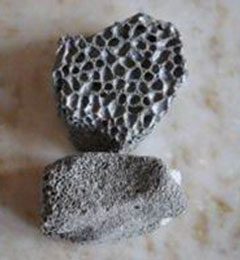E18 Västerås-SagånWhole Project Award |
|
Project Team
Client: Trafikverket
Designer: Skanska Sweden
Contractor: Skanska Sweden
-------------------------------------------------------------------------------------------------------------------------------------------------------------------------------------
Project summary
The highway E18 connects the cities Västerås and Stockholm. The purpose of the project was to widen and upgrade a section of the existing E18.
The 10 km road section only had 1 + 2 lanes in each direction, but now has 2+2 lanes as result of the project. In addition, the project has built a new interchange with a bridge over a local road, a new traffic control area for the police, as well as complementary work on existing culverts and bridges.
Some of the bigger sustainability aspects were carbon and energy, both imbedded in materials as well as emissions from machines and vehicles, waste, local ecological values, and protection of water bodies. The area surrounding E18 consist of fields, woods and a couple of small streams, one of them called Sagån. The lake Mälaren, a fresh water source for about 1 million people, is located 5 km west of the project area.
Challenges faced and Achievements
Landscape
Some of the challenges involved a projected excess of soils, run off water flooding nearby fields, and landscape values.
The project was permitted to place soil on the land of local farmers, but the project t also gave soil to another civil project located next to the highway, a new solar cell park. All the excess soil was re-located to nearby stakeholders, and the excess soil was never transported more than 10 kilometers.
Before the project, the fields right next to the E18 higway were continuously flooded by run off. Thanks to multiple community consultations and good contacts with local stakeholders, the client became aware of the problem and included better run off management in the project, with sustainable drainage systems.
In the EIA, values were connected to the flat and open landscape surrounding parts of E18. The project was designed with minimal impact on landscape values, such as placing a resting place with a big information sign in a more wooden area. To minimise the visual impact, side fences were avoided as much as possible.
Ecology and Biodiversity
Another challenge was to preserve local ecological values. An otter population living in a small stream crossing under the E18, required some attention. Otters usually don´t like swimming in culverts, hence try to cross the road instead. Therefore, the project built an otter shelf inside the culvert, which the otters could walk on. The otter shelf was designed with help from ecological expertise, and a monitoring programme will continue after the project is finished. Two small stone walls were moved and relocated within the site after consultation with the regional authorities. The walls were protected from an ecological point of view, as valuable habitats for insects and small animals. With help from ecological expertise, parts of the walls were used to create new habitats. The remaining parts of the walls were integrated in the project, were the stones were used in a bridge construction. |
 Otter shelf inside a culvert Otter shelf inside a culvert |

Physical Resources
From the start, the project team took the price and distance from the project site into account when evaluating the suppliers and their suitability. If suitable local suppliers were found, they were selected. A close collaboration between the Production and Design team led to significant carbon reductions. For example, the project came up with a solution of designing away more than 10,000 tones of asphalt, and 33,000 linear meters of lime/cementpillars. About 1,450 tonnes CO2 equivalents were saved thanks to the slimming of these materials. The project also used a more environmental friendly material, Hasopor, which is a lightweight filler. Hasopor partly replaced lime/cementpillars when stabilizing the foundation. Hasopor consists of recycled glass that is grounded down to a fine glass powder. After treatment in hot ovens, a strong foam glass material is created. |
|
To what extent did the use of CEEQUAL influence your project?
 |
The CEEQUAL assessment made the contractor and client come together even better, with clear and specific sustainability goals and a positive approach. CEEQUAL enabled the employees to engage with the sustainability values of the project - they wanted to measure how sustainable they worked. The ability to measure the good things they did good raised the involvement of the employees and created a friendly working culture, where people shared and came up with new creative solutions and raised the overall quality of the project. In the project, many employees had previous experiences from earlier CEEQUAL-projects, which was evident and brought a certain “way of working” into the project from the beginning. The project got a strong foundation, where everyone had their predetermined role and had an idea of what could be done to contribute to their work in accordance with CEEQUAL. The project members were thrilled that Trafikverket, the Swedish Transport Administration, wanted to participate and contribute in the CEEQUAL way of working. This created a good working relationship, a wide commitment and a common goal to strive for. |


 Hasopor
Hasopor